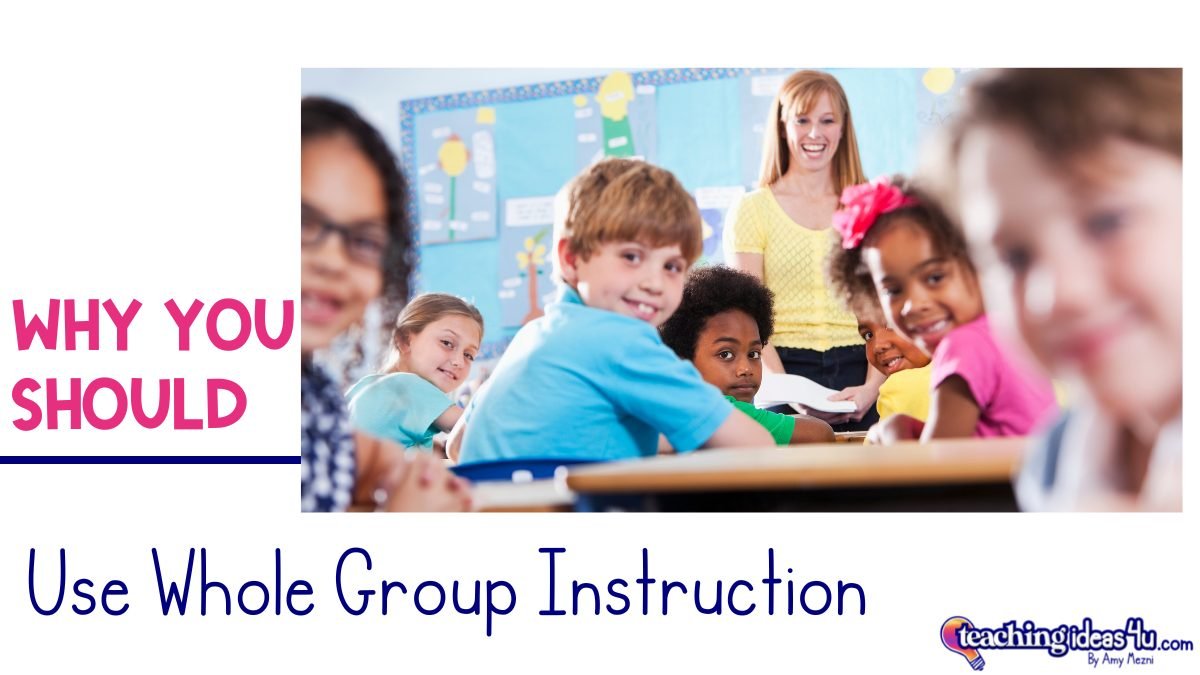Why You Should Use Whole Group Instruction
I remember when whole-group instruction became verboten in my district. We were told that no one would be considered highly effective if they didn’t use small-group instruction for the majority of the class.
I know some teachers swear by small-group instruction, but I will tell you a secret: I hated it.
Don’t get me wrong, I completely understand why we need to use small-group instruction. I just found it overwhelming. There was so much going on and so many things to remember (both for me and the students) that it just felt like a lot.
And if it felt like a lot to juggle to me, it probably felt that way to some students as well.
It is like we always say, there isn’t one magical teaching strategy that will work for everyone. So why is small-group instruction often made out to be the only best practice in teaching?
I recently read the article How to Make Reading Instruction Much, Much More Efficient by Mike Schmoker in Edweek, and it really struck a chord with me. He was saying everything I had been thinking.
There are a number of reasons why whole-group instruction is better than small-group instruction.
1. Small-group instruction is inefficient.
People criticize having teachers specialize in a subject wastes a lot of time due to students having to switch classes. Small-group instruction has the same problem - there are many wasted minutes in a day that switches activities every 20 minutes or so. If a reading block has 4 small groups per day, and each transition only takes three minutes, that is 12 minutes a day. That doesn’t seem like much, but I can guarantee it is probably at least five minutes, plus a few minutes of settling down to work. Now, factor in small group time in math, science, and social studies. Let’s say there is only one small group in each subject, making it another wasted 15 minutes. That is 30 minutes of lost time in every school day.
2. Students have less direct instruction with small groups.
Students do not get as much direct instruction when a classroom primarily uses small groups. While some students may thrive with independent learning, others definitely do not. Some of the students may meet more frequently with the teacher, but students who are deemed advanced may only meet with their teacher once or twice a week. If the class used more whole-group instruction, all students would have daily direct instruction from the teacher. In addition, studies have shown that independent work time is not as productive as instruction with a teacher.
3. Small groups take a lot of planning time.
Teachers need to plan and develop multiple small-group activities each week, differentiating for their students’ abilities. When teachers hardly have planning, how can they be expected to prepare multiple centers every week that will meet the learning needs of each student? It just isn’t realistic.
4. Small-group instruction doesn’t work for all learners.
As I said above, no strategy is one-size-fits-all. Some students are naturally more independent, and they may thrive in small groups. However, many others may struggle. When teachers consider the wide variety of personalities and learning needs, small-group instruction can be tricky to manage effectively.
5. Ability-grouping for reading has not caused large gains in reading achievement.
Although students in the U.S. have made some gains in reading achievement, studies do not support the idea that small groups are the solution. Many teachers now acknowledge the need to emphasize phonics and phonemic awareness in primary grades, and freeing up more instructional minutes would allow more time to be spent on these core skills. Note: some studies have seen promise in fluid ability groups that are frequently reevaluated to regroup students throughout the year. I am not against small-group instruction. Done well, it has the potential to meet students where they are. However, whole-group instruction also has benefits, and in many cases can be even more effective than small-group time. Teachers should hone their skills in using both types of instruction, and then tailor instruction to their students’ needs.
Practice Tests
When using small-group instruction, you want to be sure instruction is focused on students’ needs. Ideally, groups will be fluid, so students will move to different groups depending on the skill being taught. Teachers need to frequently reassess and evaluate students’ needs. These practice tests are one-way teachers can analyze which students need help with the same skill. Reading tests are available for grades 3 - 6, while math tests are available for grades 3 - 5.
References
Schmoker, Mike. “How to Make Reading Instruction Much, Much More Efficient (Opinion).” Education Week, Education Week, 24 Sept. 2021, https://www.edweek.org/teaching-learning/opinion-how-to-make-reading-instruction-much-much-more-efficient/2019/11.
Sparks, Sarah D. “Are Classroom Reading Groups the Best Way to Teach Reading? Maybe Not.” EducationWeek, 26 Aug. 2018, https://www.edweek.org/teaching-learning/are-classroom-reading-groups-the-best-way-to-teach-reading-maybe-not/2018/08

